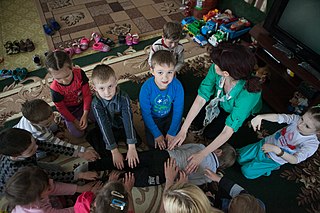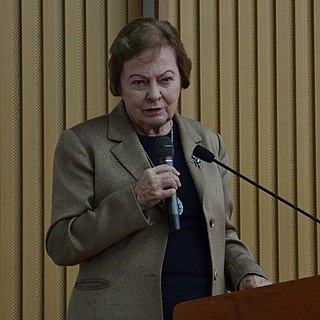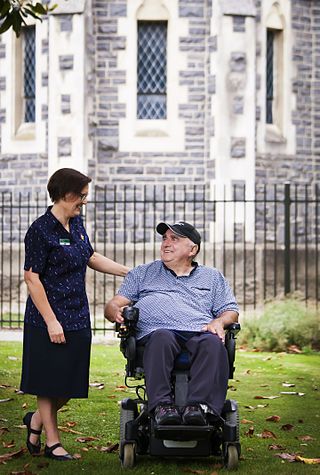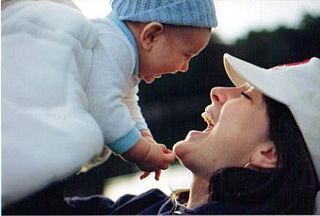In social psychology, an interpersonal relation describes a social association, connection, or affiliation between two or more persons. It overlaps significantly with the concept of social relations, which are the fundamental unit of analysis within the social sciences. Relations vary in degrees of intimacy, self-disclosure, duration, reciprocity, and power distribution. The main themes or trends of the interpersonal relations are: family, kinship, friendship, love, marriage, business, employment, clubs, neighborhoods, ethical values, support and solidarity. Interpersonal relations may be regulated by law, custom, or mutual agreement, and form the basis of social groups and societies. They appear when people communicate or act with each other within specific social contexts, and they thrive on equitable and reciprocal compromises.

Occupational therapy (OT) is a healthcare profession that involves the use of assessment and intervention to develop, recover, or maintain the meaningful activities, or occupations, of individuals, groups, or communities. The field of OT consists of health care practitioners trained and educated to improve mental and physical performance. Occupational therapists specialize in teaching, educating, and supporting participation in any activity that occupies an individual's time. It is an independent health profession sometimes categorized as an allied health profession and consists of occupational therapists (OTs) and occupational therapy assistants (OTAs). While OTs and OTAs have different roles, they both work with people who want to improve their mental and or physical health, disabilities, injuries, or impairments.
In the psychology of self, one's self-concept is a collection of beliefs about oneself. Generally, self-concept embodies the answer to the question "Who am I?".

An attachment theory is a psychological, evolutionary, and ethological theory concerning relationships between humans. The most important tenet is that young children need to develop a relationship with at least one primary caregiver for their survival, and for them to develop a healthy social and emotional functioning. The theory was formulated by psychiatrist and psychoanalyst John Bowlby (1907–1990).
Object relations theory is a school of thought in psychoanalytic theory and psychoanalysis centered around theories of stages of ego development. Its concerns include the relation of the psyche to others in childhood and the exploration of relationships between external people, as well as internal images and the relations found in them. Thinkers of the school maintain that the infant's relationship with the mother primarily determines the formation of its personality in adult life. Particularly, attachment is the bedrock of the development of the self or the psychic organization that creates the sense of identity.

Otto Friedmann Kernberg is an Austrian-born American psychoanalyst and professor of psychiatry at Weill Cornell Medicine. He is most widely known for his psychoanalytic theories on borderline personality organization and narcissistic pathology. In addition, his work has been central in integrating postwar ego psychology with Kleinian and other object relations perspectives. His integrative writings were central to the development of modern object relations, a school within modern psychoanalysis.
In psychoanalysis, psychosexual development is a central element of the sexual drive theory. According to Freud, personality develops through a series of childhood stages in which pleasure seeking energies from the child become focused on certain erogenous areas. An erogenous zone is characterized as an area of the body that is particularly sensitive to stimulation. The five psychosexual stages are the oral, the anal, the phallic, the latent, and the genital. The erogenous zone associated with each stage serves as a source of pleasure. Being unsatisfied at any particular stage can result in fixation. On the other hand, being satisfied can result in a healthy personality. Sigmund Freud proposed that if the child experienced frustration at any of the psychosexual developmental stages, they would experience anxiety that would persist into adulthood as a neurosis, a functional mental disorder.
Nancy Julia Chodorow is an American sociologist and professor. She began her career as a professor of Women's studies at Wellesley College in 1973, and from 1974 on taught at the University of California, Santa Cruz, until 1986. She then was a professor in the departments of sociology and clinical psychology at the University of California, Berkeley until she resigned in 1986, after which she taught psychiatry at Harvard Medical School/Cambridge Health Alliance. Chodorow is often described as a leader in feminist thought, especially in the realms of psychoanalysis and psychology.

Play therapy refers to a range of methods of capitalising on children's natural urge to explore and harnessing it to meet and respond to the developmental and later also their mental health needs. It is also used for forensic or psychological assessment purposes where the individual is too young or too traumatised to give a verbal account of adverse, abusive or potentially criminal circumstances in their life.

William Ronald Dodds Fairbairn FRSE was a Scottish psychiatrist, psychoanalyst and a central figure in the development of the Object Relations Theory of psychoanalysis. He was generally known and referred to as "W. Ronald D. Fairbairn".
Self-disclosure is a process of communication by which one person reveals information about themselves to another. The information can be descriptive or evaluative, and can include thoughts, feelings, aspirations, goals, failures, successes, fears, and dreams, as well as one's likes, dislikes, and favorites.
Caring in intimate relationships is the practice of providing care and support to an intimate relationship partner. Caregiving behaviours are aimed at reducing the partner's distress and supporting their coping efforts in situations of either threat or challenge. Caregiving may include emotional support and/or instrumental support. Effective caregiving behaviour enhances the care-recipient's psychological well-being, as well as the quality of the relationship between the caregiver and the care-recipient. However, certain suboptimal caregiving strategies may be either ineffective or even detrimental to coping.
Individual psychology is a psychological method or science founded by the Viennese psychiatrist Alfred Adler. The English edition of Adler's work on the subject (1925) is a collection of papers and lectures given mainly between 1912 and 1914. The papers cover the whole range of human psychology in a single survey, and were intended to mirror the indivisible unity of the personality.
Self-actualization, in Maslow's hierarchy of needs, is the highest level of psychological development, where personal potential is fully realized after basic bodily and ego needs have been fulfilled. The highest level of psychological development in Maslow’s hierarchy of needs is self-transcendence.

Nel Noddings was an American feminist, educator, and philosopher best known for her work in philosophy of education, educational theory, and ethics of care.

A caregiver, carer or support worker is a paid or unpaid person who helps an individual with activities of daily living. Caregivers who are members of a care recipient's family or social network, and who may have no specific professional training, are often described as informal caregivers. Caregivers most commonly assist with impairments related to old age, disability, a disease, or a mental disorder.
Emotional conflict is the presence of different and opposing emotions relating to a situation that has recently taken place or is in the process of being unfolded. They may be accompanied at times by a physical discomfort, especially when a functional disturbance has become associated with an emotional conflict in childhood, and in particular by tension headaches "expressing a state of inner tension...[or] caused by an unconscious conflict".

Maternal deprivation is a scientific term summarising the early work of psychiatrist and psychoanalyst John Bowlby on the effects of separating infants and young children from their mother. Although the effect of loss of the mother on the developing child had been considered earlier by Freud and other theorists, Bowlby's work on delinquent and affectionless children and the effects of hospital and institutional care led to his being commissioned to write the World Health Organization's report on the mental health of homeless children in post-war Europe whilst he was head of the Department for Children and Parents at the Tavistock Clinic in London after World War II. The result was the monograph Maternal Care and Mental Health published in 1951, which sets out the maternal deprivation hypothesis.
An informal or primary caregiver is an individual in a cancer patient's life that provides unpaid assistance and cancer-related care. Caregiving is defined as the processing of assiting someone who can't care for themselves, which includes physical, mental, emotional, social, and spiritual needs. Due to the typically late onset of cancer, caregivers are often the spouses and/or children of patients, but may also be parents, other family members, or close friends. Taking care of family members at home is a complicated experience. The relationships involved constantly shift and change, in expected and unexpected ways. The expected or expected changes can negatively affect physical health, emotions, social life, and spiritual well-being of the caregiver. Informal caregivers are a major form of support for the cancer patient because they provide most care outside of the hospital environment. This support includes:
Parentification or parent–child role reversal is the process of role reversal whereby a child or adolescent is obliged to support the family system in ways that are developmentally inappropriate and overly burdensome. For example, it is developmentally appropriate for even a very young child to help adults prepare a meal for the family to eat, but it is not developmentally appropriate for a young child to be required to provide and prepare food for the whole family alone. However, if the task is developmentally appropriate, such as a young child fetching an item for a parent or a teenager preparing a meal, then it is not a case of parentification, even if that task supports the family as a whole, relieves some of the burden on the parents, or is not the teenager's preferred activity.







